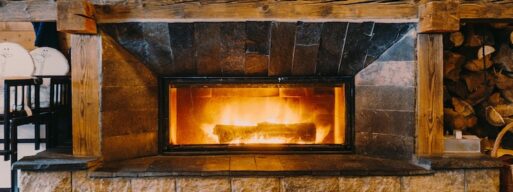Signs It’s Time to Inspect Your Gas Fireplace
Gas fireplaces offer a convenient way to keep your home warm. They provide consistent heat without any hassle or strenuous maintenance. Still, it’s critical that you pay attention to the upkeep of your fireplace. Many problems can occur without your knowledge that can hinder your fireplace’s ability to function properly and safely.
Hiring a fireplace maintenance professional to inspect your fireplace is the best way to catch any issues. We recommend doing this at least once a year. Keep reading to learn about what you can expect during a fireplace inspection, and what issues you’ll be preventing.
What Is a Fireplace Inspection?
During a fireplace inspection, a technician looks at both the exterior and interior of your fireplace to detect any issues. They’ll look for disruptions, like debris or buildup, and make sure that all parts work correctly. Then, they’ll perform any necessary repairs and polish your fireplace.
Steps to Take
The steps of a fireplace inspection may depend on your particular fireplace or inspector. These are some common steps taken:
- Clean the safety door, pilot or ignition, and gas logs.
- Remove all flammable debris and check for related risks.
- Test the fireplace’s heat output and other controls.
- Test your carbon monoxide detector.
- Clean the vent, flue or chimney, and replace the chimney cap if necessary.
How Frequently Should I Inspect My Fireplace?
You should have your fireplace inspected at least once a year. If you wait longer, your risk of running into a pest problem or safety issues will increase greatly. If you use your fireplace year-round, you may consider increasing the frequency of checkups.
READ MORE: End of Season Fireplace Cleaning Tips
Why You Need to Inspect Your Gas Fireplace
Even if your gas fireplace seems like it’s working correctly, it may have problems that you are unable to detect with the naked eye. You may also know that you want to clean your fireplace, but you are not familiar with the correct safety protocol. Performing a fireplace inspection can ensure that your fireplace is working correctly and is restored to its best condition. Some of the most common, hazardous gas fireplace problems are listed below.
Prevent Malfunctioning Components
An inspector can detect any parts that are malfunctioning in your fireplace. Some examples of what they might check include:
- Valves and connections, to ensure that no leaks will occur.
- Thermopile and thermocouples, which are the components that turn thermal energy into electrical energy.
- Ceramic logs, to ensure they are working properly and positioned correctly.
It is vital for your safety that your fireplace’s components work correctly. Malfunctioning components can cause fire damage, shatter glass doors, or cause carbon monoxide poisoning.
Prevent Carbon Monoxide Poisoning
Carbon monoxide is a gas produced by burning gasoline or other fuel. It is colourless, odourless and tasteless, making it hard to detect. However, it is extremely dangerous. When you are exposed to carbon monoxide, it can enter your bloodstream and replace oxygen. This can lead to severe tissue damage, and may be fatal.
If a gas fireplace is not properly maintained or ventilated, it can create carbon monoxide. Your home should have a functioning carbon monoxide detector, and this device should be replaced every 5-7 years. To prevent any issues in the first place, inspect your fireplace.
Prevent Blocked Vents
A gas fireplace relies on a venting system to filter air safely. Similar to a chimney, the venting system can become obstructed by debris and pests. If your venting system becomes clogged, you may find yourself at risk for carbon monoxide poisoning. Even if you use a vent-free gas fireplace, you should still perform inspections to ensure that your oxygen level detector is working properly.
READ MORE: Fireplace Venting Explained
Prevent Buildup of Dirt and Debris
There are plenty of ways for debris to enter your fireplace: moisture from mortar joints, deteriorating ceramic logs, pests living in your fireplace when not in use, and of course, creosote buildup. Some of these are flammable, and they can block your fireplace from proper ventilation. An inspector can find the cause of your debris buildup and solve the problem before it gets worse.
Prevent Gas Leaks
Any gas appliance can develop leaks, and fireplaces are no exception. You may experience a leak if the gas line is punctured or the valve is damaged. Gas leaks are extremely hazardous and can cause explosions.
Reduce Risk of House Fire
Cracks, buildup, and improper installation can all cause house fires. An inspection can ensure that your glass door properly protects the fire, and that nothing in the fireplace’s interior will cause any problems.
READ MORE: Why is Your Fireplace Smoking Up the House?
Installing a gas fireplace into your home can bring warmth at a low cost, without the hassle of heavy maintenance. However, you still need to ensure that your fireplace is in top shape to guarantee your safety. Getting a professional fireplace inspector to perform an inspection is the best way to guarantee that your fireplace operates correctly and that your home is safe.

